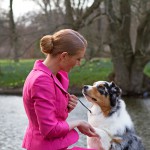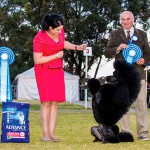Interview with Mrs. Carla Molinari • Interviewed by Ante Lucin
Published in Best in Show Annual 2015
BIS: Dear Mrs. Molinari, first of all we would like to thank you for taking some time to answer questions for the Best inShow magazine annual. I am sure our readers will appreciate the possibility of learning something about your very interesting life. How did you enter the world of show dogs? Was anyone from your family involved with dogs?
Carla: I have been fascinated by dogs since early childhood. No one in my family had this passion, but my mother had a Sealyham Terrier when I was a very young child.
< strong >BIS: When did you get your first dog, and which breed was it? Why that breed?
Carla: I got my first dog when I was 8 years old. My grandfather took me to a pet shop in downtown Lisbon (not the fancy style we have nowadays). There were 2 puppies there, Wire Fox Terriers; I got one, a bitch, BIRBA. At that time I did not even know that dog shows existed! German Shepherds came later, in 1963, when I discovered the amazing world of show dogs.
BIS: When thinking about your early days as an exhibitor, what would you mention as your most exciting win?
Carla: Definitely my first BIS, with my GSD Ch Thor Della Meta in 1965.
BIS: What is your kennel name, and can you tell us which breeds are/were you breeding?
Carla: My kennel name is DO VALE NEGRO (reg. FCI in 1963). I was breeding GSDs then.
Later I bred Afghan Hounds, Salukis, Whippets, IGs, Dachshunds, Chins, Pointers, Portuguese Water Dogs and Podengos.

BIS: Can you mention some of the most important dogs bred by you?
Carla: There were so many International Champions, multi champions, in all these breedsÖ but in 1974 Am Ch BLUE BOY DO VALE NEGRO gathered 12 championship titles for his owners Rafael de Santiago and Roberto Velez Pico. He was an Afghan Hound, and to get so many country titles in the seventies, when the breed was extremely popular, was very unusual!
BIS: How important is it for someone who wants to be a good judge to have a background as a breeder?
Carla: Very important. When you breed, you must be a perfectionist, and a good breeder must not be kennel blind. Only when you stop believing that the dogs you bred are the best in the world and see through their faults, you become a good judge!
BIS: When did you become a judge and who were your mentors?
Carla: I started my judging ìcareerî in 1976 . I had been working as a ring steward for many years, and visiting large shows such as Crufts and Westminster regularly. My mentors? Dr Antonio Cabral, Denise Nizet de Leemans, and others. I learned a lot from Hope Waters of Saluki Burydown fame. I have also been an avid reader of anything related to dogsÖ I read magazines, books, etc. non stop. I even used to know the KC stud books by heart: all breeds, all numbers, all owners. What a memory!!!
BIS: You have travelled all over the world. Can you tell us if there are countries or shows which are on your list of favourites?
Carla: Small countries where judges are respected and treated well have provided me with the best judging experiences, but I have also learned a lot from judging in big countries, and in some of them I have also enjoyed myself. I particularly like to judge in Asia, and feel very much at home there.

BIS: You have judged BIS at many prestigious events, including the World dog show in Porto. When having a very strong line up full of top quality dogs and well known winners, how do you find the best?
Carla: You are asking me to reveal my deepest secrets! I have been blessed with ìan eye for a dogî, something that cannot be taught in any school for judges as it is an inborn trait. When I walk into the big ring I let the dog who must win ìtell meî that he wants to win! It is actually very easy for me to pick my number oneÖ sometimes it is numbers two and three that are difficult to decide upon.
BIS: What do you think was better in the dog world when you started as a breeder, exhibitor and a judge, and what is better now?
Carla: Back then it was all done for pleasure, passion and sport. And now winning and making money come first.
BIS: You are active on Facebook. There are many discussions if this social network is bringing more good or bad into the dog world. What do you think?
Carla: The world has gone global, communication is a necessity for all of us. Instant communication is a blessing, and in the 21st century we do not know how to live any other way. This is true even for us ìold guard relicsî. Moderate discussions and exposure on FB can be very positive. It is good to be able to be in immediate contact!
BIS: How did you get involved with the Portuguese kennel club (CPC)?
Carla: It was in 1965, through my vet Dr Antonio Cabral; he was the President then. He had the merit of understanding my passion!
BIS: When did you become the President and how difficult is to be in that position?
Carla: In 1985. At the beginning it was very difficult. You see, I was a woman in a traditionally menís world! Remember that at that time the Kennel Club of England had a special ladies branch, a special room, and women were not allowed in the menís areas! The CPC was moulded on the Kennel Club model, so the men of that time really resented the fact that I, a blonde good-looking ìforeignerî (I have an Italian name) was taking taking over, with very modern far-fetched ideas on how to run ì the dog gameî in this very traditional and old fashioned country.

BIS: I have witnessed it myself – and I am sure many will agree – that Portugal is at the moment one of the top dog countries in Europe. You have top quality breeders who win all over, your judges are travelling all over the world, judging the most prestigious events and enjoying great respect, and your shows are always organized at the highest level, with constantly increaseing entry numbers. What is the secret of your success?
Carla: I pride myself on helping create the conditions which made it possible, for taking the CPC from conservative to ultra modern, for giving our breeders and judges the possibility to see the way the avantgarde world of dogs functions. I brought all the latest trends to my country, organized two absolutely successful events – the European Winner Show in 1994 and the World Dog Show in 2001, and thus the young breeders and judges grew up with this exposure. But the merit is only partially mine – I am very proud that we had such great judges and breeders who just needed the incentives I provided to show their full potential.
BIS: How important is the constant care for the national breeds?
Carla: Of the utmost importance! They are our heritage and our national treasure! I have been passionately dedicated to their preservation for over 40 years, and I am very proud that nowadays many of them are appreciated worldwide. Our Portuguese Water Dog International Congress in the Algarve in 2013 brought together 200 people from 16 countries and 4 continents. Quite a feat!
BIS: You are the only woman in the FCI General Committee. How do you see FCI today, and what do you think are the biggest problems of the world of purebred dogs today?
Carla: The FCI is ever growing in numbers, popularity, and range. It is a huge challenge to have the responsibility to manage it! But we have introduced many changes, and they are now becoming quite visible.
The biggest problem in the purebred dog world today is that the concept of ìbreedî and ìtypeî is totally changing in a world where more and more dogs are humanized and treated as a manís life companion instead of functional helper. So we are slowly losing the concept of ìpurebred according to the standardî, transforming it into ìpurebred according to its healthî. This is a difficult concept to adapt to.

BIS: In the last years the world of show dogs has been under attack from many animal rights groups. If you would need to explain to them why we need purebred dogs and dog shows what would you say?
Carla: Never lose track to the fact that shows are the place where the dogsí morphologic qualities are examined according to the standard of the breed in order to select the best possible specimens for reproduction, to improve the future of each breed. Nowadays not only standard points, but also health points are to be taken in consideration by the judges.
Our work is of the utmost importance to preserve healthy, typical breeds. And pure breeds have specific functions and temperament characters that are much more reliable for that purpose than mixed breeds.
BIS: How do you see the dog world in ten years? What do you think needs to be improved, and which negative aspects of today should we try to stop?
Carla: More and more professionally run, which is not good in itself, but somehow inevitable. We should try to avoid exaggerations in any field, and never lose track of the purpose for which each breed has been selected over the years, which certainly is not to run around a ring to exclusively win Championship titles! Our breeds, our purebred dogs, will only survive if they have a function in our society! Our breeders, judges, and exhibitors are all responsible for the future of the dog world; they must keep this in mind at all times. Our future is in their hands!
BIS: At the end, what would be your message for our readers, and especially to young people starting into our sport?
Carla: I would say: ìBreed for passion, and not for gain!î If you overbreed because you are making a living out of it, you are destroying the inner core of our sport. If you show, do it with an open mind and willingness to learn; do not be blinded by the looks of your dog, because you can rest assured that it is the ìprettiest of them allî in your own mind only! When you enter a ring, you are asking for an opinion, so gracefully accept it and try to learn a new lesson with every new experience – good or bad. In the long run this attitude will pay you back in a million ways! It did to me.




